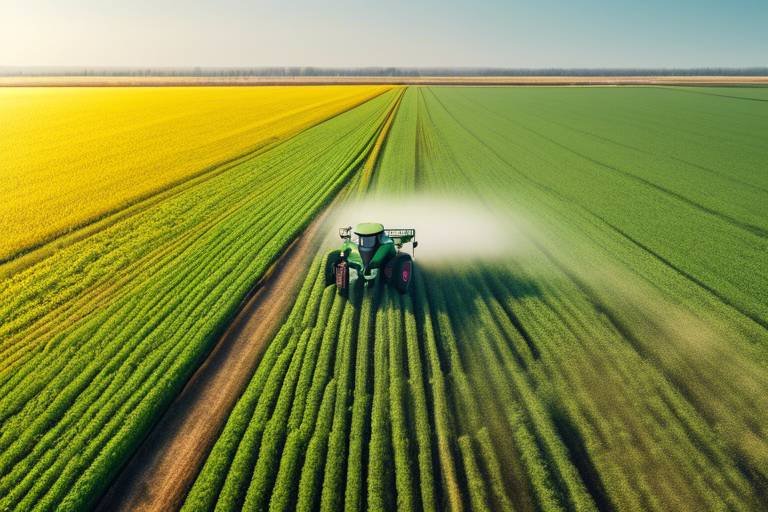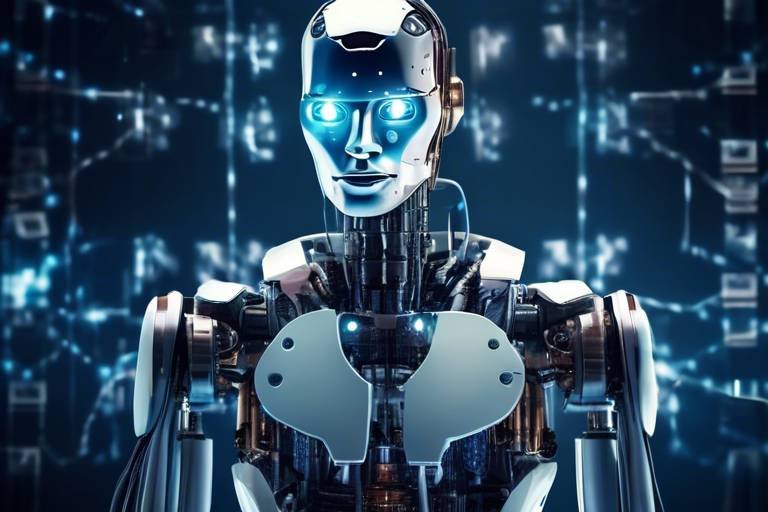Role of AI in Wildlife Conservation
In a world where wildlife faces unprecedented threats from habitat loss, climate change, and poaching, the role of artificial intelligence (AI) in wildlife conservation has never been more crucial. Imagine a world where technology not only helps us understand the complexities of nature but also empowers us to protect it. AI is transforming the landscape of conservation efforts, making it possible to gather and analyze data at an astonishing scale and speed. This revolution in technology is akin to having a digital assistant that never tires and constantly learns, enabling conservationists to make informed decisions that can save endangered species and restore fragile ecosystems.
The integration of AI into conservation strategies is paving the way for innovative solutions that were once thought to be the stuff of science fiction. From monitoring animal populations to predicting environmental changes, AI is enhancing our ability to act swiftly and effectively. As we delve deeper into the various applications of AI in wildlife conservation, it becomes clear that this technology is not just a tool; it’s a game-changer.
One of the most significant advantages of AI in wildlife conservation is its ability to facilitate data collection. Traditional methods of gathering ecological data can be time-consuming and often yield incomplete information. However, with AI, researchers can now collect and analyze vast amounts of data from diverse sources, including satellite imagery, camera traps, and even social media. This capability allows for a more comprehensive understanding of wildlife populations and their habitats.
For instance, AI algorithms can process images from camera traps, identifying species and counting individuals with remarkable accuracy. This not only saves time but also provides real-time insights that are crucial for monitoring endangered species. Imagine a researcher being able to analyze thousands of images in a fraction of the time it would take manually—this is the power of AI.
Predictive analytics is another exciting application of AI in wildlife conservation. By analyzing historical data and identifying patterns, AI can forecast potential threats to wildlife. This proactive approach enables conservationists to implement measures before a problem escalates. For example, if AI predicts a rise in poaching incidents in a particular area, rangers can increase patrols and surveillance, effectively mitigating the risk.
AI algorithms are particularly adept at modeling species distributions based on various environmental variables. This modeling offers vital insights into habitat preferences and potential changes due to factors like climate change or human activities. By understanding where species are likely to thrive or decline, conservationists can focus their efforts on protecting critical habitats.
Machine learning techniques take this a step further by continuously learning from new data. As more information becomes available, these algorithms refine their predictions, enhancing the accuracy of species distribution models. This ongoing learning process is akin to a student mastering a subject over time, becoming increasingly proficient and insightful.
Combining remote sensing technologies with AI allows for real-time monitoring of habitats. This integration means that conservationists can detect changes in ecosystems almost instantaneously, enabling timely interventions to protect vulnerable areas from degradation. Think of it as having a surveillance system for the environment, where any signs of distress are immediately flagged for action.
AI tools are also revolutionizing the way we understand animal behavior. By analyzing video and audio data, AI can provide insights into species interactions, mating habits, and responses to environmental changes. This information is crucial for developing effective conservation strategies. For instance, understanding how animals react to habitat disturbances can inform efforts to minimize human impact on their environments.
As poaching remains a significant threat to wildlife, AI technologies are increasingly being utilized to combat this issue. By analyzing patterns of illegal activities in protected areas, AI enhances the effectiveness of anti-poaching initiatives. Imagine having a system that can predict where poaching is likely to occur based on historical data and environmental factors—this is the future of conservation.
Smart surveillance systems equipped with AI algorithms can identify suspicious activities in real-time, allowing rangers to respond quickly to potential threats against wildlife. This immediate response capability is akin to having a watchful guardian that never sleeps, ensuring that wildlife is protected around the clock.
Furthermore, AI aids law enforcement by providing data-driven insights that optimize patrol routes and allocate resources effectively. This strategic approach significantly increases the chances of preventing poaching incidents, making conservation efforts more robust and efficient.
Finally, AI-driven platforms enhance community engagement by educating local populations about wildlife conservation. By fostering a sense of responsibility and encouraging sustainable practices, these initiatives benefit both wildlife and communities. After all, conservation is not just about protecting animals; it’s about creating a harmonious relationship between nature and people.
- How does AI improve wildlife conservation? AI enhances data collection, predictive analytics, and real-time monitoring, allowing for more effective conservation strategies.
- Can AI help in combatting poaching? Yes, AI technologies can analyze patterns and detect illegal activities, improving the effectiveness of anti-poaching initiatives.
- What role does community engagement play in AI-driven conservation? Community engagement is crucial as it fosters responsibility and encourages sustainable practices that benefit both wildlife and local populations.

AI-Powered Data Collection
Artificial intelligence has become a game changer in the realm of wildlife conservation, particularly in the area of data collection. Traditional methods of gathering ecological data often involve a labor-intensive process that can be slow and prone to human error. However, with the advent of AI technologies, researchers can now gather and analyze vast amounts of data with remarkable efficiency. Imagine having the ability to monitor wildlife populations and their habitats in real-time, making it possible to respond to changes almost instantaneously. This is not just a dream; it’s the reality that AI is creating.
One of the key benefits of AI-powered data collection is its ability to process large datasets from various sources, such as satellite imagery, camera traps, and acoustic sensors. For instance, AI algorithms can sift through thousands of images captured by camera traps to identify species and count populations, something that would take humans weeks or even months to accomplish. This capability not only saves time but also increases the accuracy of the data being collected, leading to better-informed conservation strategies.
Furthermore, AI can enhance data collection in several ways:
- Automated Monitoring: AI systems can be deployed to automatically monitor wildlife through video feeds, detecting and analyzing animal movements without the need for constant human supervision.
- Data Integration: AI can integrate data from multiple sources, creating a comprehensive view of wildlife activity and habitat conditions.
- Pattern Recognition: Machine learning algorithms excel at recognizing patterns in data, allowing researchers to identify trends that might otherwise go unnoticed.
For example, researchers studying the migration patterns of elephants can use AI to analyze GPS tracking data alongside environmental data to understand how changes in climate or human encroachment affect their movements. This kind of analysis not only helps in understanding the current state of wildlife but also aids in predicting future behaviors and potential threats.
Moreover, AI-powered tools can assist in data visualization, making complex datasets more accessible and understandable. By transforming raw data into interactive maps and graphs, conservationists can easily communicate their findings to stakeholders, policymakers, and the general public. This transparency is crucial for garnering support for conservation initiatives and ensuring that decisions are backed by solid evidence.
In summary, AI is revolutionizing the way we collect and analyze data in wildlife conservation. Its ability to process and interpret vast amounts of information quickly and accurately is empowering conservationists to make better decisions, ultimately leading to more effective strategies for protecting endangered species and their habitats.

Predictive Analytics in Conservation
Predictive analytics is revolutionizing the field of wildlife conservation by providing powerful tools to anticipate and mitigate threats before they become critical. Imagine having the ability to foresee potential dangers lurking in the shadows of our ecosystems—this is precisely what AI-driven predictive analytics offers. By analyzing vast datasets encompassing various environmental variables, AI can help conservationists identify patterns and trends that might otherwise go unnoticed. This foresight is crucial in a world where every species is fighting for survival against a backdrop of climate change, habitat destruction, and human encroachment.
At the heart of predictive analytics lies the ability to model potential scenarios based on historical data. For instance, researchers can input data related to species populations, migration patterns, and environmental changes into sophisticated algorithms. The result? A clearer picture of how these factors interact and what they mean for the future of wildlife. This isn't just about crunching numbers; it's about telling a story—one that can guide conservation strategies and inform policy decisions. The insights gained can lead to proactive measures that protect vulnerable species and ensure their habitats remain intact.
One of the most impressive applications of predictive analytics in conservation is species distribution modeling. By leveraging AI algorithms, researchers can create detailed models that predict where species are likely to thrive based on a variety of environmental factors. These models take into account elements such as temperature, precipitation, and vegetation types, which all play a significant role in determining habitat suitability. For example, if a certain area is projected to become increasingly arid due to climate change, conservationists can use this information to prioritize areas for protection or restoration.
Moreover, the dynamic nature of these models allows for continuous improvement. As new data becomes available, machine learning techniques can refine the predictions, making them more accurate over time. This iterative process not only enhances our understanding of species’ needs but also equips conservationists with the tools to adapt their strategies in real-time.
Machine learning, a subset of AI, is particularly powerful in enhancing species distribution models. These techniques enable algorithms to learn from new data inputs, adjusting their predictions based on the latest observations. For instance, if a specific species begins to migrate to a new area, machine learning can quickly integrate this information, allowing conservationists to adapt their management strategies accordingly. This adaptability is vital in a rapidly changing world, where traditional methods may fall short.
Integrating remote sensing technologies with predictive analytics takes conservation efforts to a whole new level. By utilizing satellite imagery and aerial data, conservationists can monitor habitats in real-time, identifying changes that may indicate threats to wildlife. For example, if deforestation is detected in a critical habitat, predictive analytics can help assess the potential impact on local species, allowing for timely interventions. This combination of remote sensing and AI not only enhances our understanding of ecosystems but also empowers conservationists to act swiftly and effectively.
In conclusion, predictive analytics is not just a buzzword; it is a game-changer in wildlife conservation. By harnessing the power of AI, conservationists can anticipate challenges, make informed decisions, and ultimately safeguard the precious biodiversity that our planet holds. As we continue to face unprecedented environmental changes, the role of predictive analytics in conservation will only grow more significant, ensuring that we can protect our wildlife for generations to come.

Species Distribution Modeling
Species distribution modeling (SDM) is a fascinating application of artificial intelligence that plays a crucial role in wildlife conservation. Imagine trying to find a needle in a haystack, but instead of a needle, you're searching for the ideal habitat for a rare species. AI algorithms help researchers tackle this challenge by analyzing vast amounts of ecological data to predict where specific species are likely to thrive based on various environmental factors. This predictive capability is not just a theoretical exercise; it has real-world implications for conservation strategies.
By utilizing data such as temperature, precipitation, vegetation types, and even human activity, AI can create intricate models that visualize potential habitats. These models provide insights into how different species interact with their environments and how changes—whether due to climate change, urbanization, or deforestation—might affect their distribution. For instance, if a certain species is known to prefer a specific temperature range, AI can highlight areas that meet those criteria, even projecting future shifts in suitable habitats as climate patterns evolve.
One of the most exciting aspects of species distribution modeling is its ability to adapt and improve over time. With the power of machine learning, these algorithms continuously refine their predictions as new data becomes available. This iterative process means that conservationists can stay ahead of the curve, adjusting their strategies based on the most current information. Imagine having a crystal ball that not only tells you where a species might be found today but also where it is likely to be in the coming years. That's the power of AI in action!
Moreover, the application of remote sensing technologies enhances the effectiveness of species distribution modeling. By integrating satellite imagery and aerial surveys with AI, researchers can monitor vast landscapes in real-time, identifying changes in habitat that may impact wildlife populations. This synergy allows for timely interventions, ensuring that conservation efforts are both proactive and responsive.
In summary, species distribution modeling is a game-changer in wildlife conservation. It equips researchers with the tools to make informed decisions, allocate resources effectively, and ultimately protect endangered species. As we continue to harness the power of AI, the potential for preserving biodiversity and restoring ecosystems becomes increasingly attainable.
- What is species distribution modeling?
Species distribution modeling is a method used to predict the distribution of species across different environments based on various ecological factors. - How does AI enhance species distribution modeling?
AI enhances species distribution modeling by analyzing large datasets and continuously learning from new information, improving the accuracy of predictions over time. - Why is species distribution modeling important for conservation?
It helps conservationists identify critical habitats, predict how species may respond to environmental changes, and develop effective conservation strategies.

Machine Learning Techniques
Machine learning techniques are revolutionizing the field of wildlife conservation by providing researchers with powerful tools to analyze complex ecological data. Imagine trying to find a needle in a haystack—this is akin to the challenge conservationists face when attempting to understand the intricate behaviors and patterns of wildlife. However, with machine learning, this task becomes significantly easier. By employing algorithms that can learn from vast datasets, researchers can derive insights that were previously unattainable using traditional methods.
One of the most exciting aspects of machine learning in conservation is its ability to improve the accuracy of species distribution models. These models predict where certain species are likely to be found based on various environmental factors, such as temperature, vegetation, and human activity. As new data is collected—whether through field surveys, remote sensing, or citizen science—machine learning algorithms continuously refine their predictions. This iterative learning process means that conservationists can make more informed decisions about habitat protection and restoration efforts.
Moreover, machine learning techniques can analyze patterns in animal movements and behaviors, revealing how species interact with their environment and each other. For instance, algorithms can sift through thousands of hours of video footage from camera traps, identifying individual animals and tracking their movements over time. This capability not only enhances our understanding of species behavior but also informs strategies for mitigating human-wildlife conflict, such as determining optimal times for livestock grazing or identifying critical migration corridors.
In addition to analyzing behavioral data, machine learning can also assist in identifying potential threats to wildlife. By examining historical data on poaching incidents, habitat destruction, and climate change impacts, algorithms can predict where and when these threats are most likely to occur. This predictive power enables conservationists to implement proactive measures, such as deploying ranger patrols in high-risk areas or establishing conservation easements in vulnerable habitats.
To illustrate the impact of machine learning on wildlife conservation, consider the following table that summarizes key applications:
| Application | Description | Benefits |
|---|---|---|
| Species Distribution Modeling | Predicts species locations based on environmental factors. | Informs habitat protection strategies. |
| Behavioral Analysis | Analyzes animal movements and interactions. | Enhances understanding of species ecology. |
| Threat Prediction | Identifies potential threats to wildlife populations. | Enables proactive conservation measures. |
Ultimately, the integration of machine learning techniques into wildlife conservation not only enhances the precision of data analysis but also amplifies the effectiveness of conservation strategies. As we continue to harness the power of AI and machine learning, we move closer to a future where endangered species can thrive, and ecosystems can be preserved for generations to come.
- What is machine learning in wildlife conservation? Machine learning in wildlife conservation refers to the use of algorithms that can learn from data to analyze patterns, predict outcomes, and enhance decision-making in conservation efforts.
- How does machine learning improve species distribution models? Machine learning improves species distribution models by continuously learning from new data, allowing for more accurate predictions of where species are likely to be found based on changing environmental conditions.
- Can machine learning help combat poaching? Yes, machine learning can analyze historical data on poaching incidents to predict where and when poaching is most likely to occur, enabling conservationists to take proactive measures.
- What role does AI play in analyzing animal behavior? AI tools can process large amounts of video and audio data to analyze animal behaviors, providing insights into interactions, mating habits, and responses to environmental changes.

Remote Sensing Applications
This article explores how artificial intelligence is transforming wildlife conservation efforts, enhancing data collection, improving decision-making, and ultimately contributing to the preservation of endangered species and ecosystems.
Artificial intelligence facilitates the gathering and analysis of vast amounts of ecological data, enabling researchers to monitor wildlife populations and habitats more efficiently than traditional methods.
Predictive analytics powered by AI allows conservationists to forecast potential threats to wildlife, helping them to implement proactive measures to mitigate risks before they escalate.
AI algorithms can model species distributions based on environmental variables, providing insights into habitat preferences and potential changes due to climate change or human activities.
Machine learning techniques enhance the accuracy of species distribution models by continuously learning from new data, improving predictions over time and aiding conservation strategies.
Remote sensing technologies, when combined with AI, enable real-time monitoring of habitats, allowing for timely interventions to protect vulnerable ecosystems from degradation. Imagine having a bird's-eye view of the Earth's surface, where satellites capture detailed images and data about various ecosystems. This powerful combination of AI and remote sensing can analyze these images to detect changes in land use, deforestation, and even the health of specific species. For instance, AI algorithms can process satellite imagery to identify areas where illegal logging or land encroachment is taking place, alerting conservationists to act swiftly.
Furthermore, remote sensing applications can track changes in climate patterns, helping scientists understand how these shifts impact wildlife habitats. By analyzing temperature variations, rainfall patterns, and other environmental factors, AI can assist in predicting how species might adapt or migrate in response to these changes. This proactive approach is crucial in developing conservation strategies that are not only reactive but also preventive.
In addition, the integration of drones equipped with AI technology has revolutionized wildlife monitoring. These drones can cover large areas quickly and provide high-resolution images that help in assessing the health of ecosystems. For example, they can be used to monitor the migration patterns of endangered species or to survey habitats that are difficult to access on foot. The data collected can then be analyzed to make informed decisions about conservation efforts.
AI tools analyze animal behavior through video and audio data, offering insights into species interactions, mating habits, and responses to environmental changes, which are crucial for conservation efforts.
AI technologies are increasingly being utilized to combat poaching by analyzing patterns and detecting illegal activities in protected areas, enhancing the effectiveness of anti-poaching initiatives.
Smart surveillance systems equipped with AI algorithms can identify suspicious activities in real-time, allowing rangers to respond quickly to potential threats against wildlife.
AI aids law enforcement by providing data-driven insights to optimize patrol routes and allocate resources effectively, significantly increasing the chances of preventing poaching incidents.
AI-driven platforms enhance community engagement by educating local populations about wildlife conservation, fostering a sense of responsibility and encouraging sustainable practices that benefit both wildlife and communities.
- How does AI help in wildlife conservation?
AI assists in data collection, predictive analytics, and real-time monitoring, allowing for more effective conservation strategies. - What role do drones play in wildlife monitoring?
Drones equipped with AI can cover large areas, providing high-resolution images and data for assessing wildlife habitats. - Can AI predict future threats to wildlife?
Yes, AI uses predictive analytics to forecast potential threats, enabling proactive measures to protect endangered species. - How does community engagement impact conservation efforts?
Educating local communities fosters a sense of responsibility and encourages sustainable practices that benefit both wildlife and people.

Behavioral Analysis of Wildlife
Understanding the behaviors and habits of wildlife is crucial for effective conservation efforts. With the advent of artificial intelligence, researchers are now able to analyze animal behavior in ways that were previously unimaginable. AI tools, particularly those that process video and audio data, have revolutionized the way we observe and interpret the interactions within and between species. Imagine being able to watch a documentary on wildlife, but instead of a narrator, you have a sophisticated AI that can analyze every sound and movement, providing insights that even the most seasoned wildlife expert might miss.
For instance, AI can track the mating habits of endangered species through video footage, identifying patterns that reveal the best times and places for breeding. This data is invaluable, as it allows conservationists to create targeted strategies aimed at increasing population numbers. Moreover, AI can analyze the social dynamics of animal groups, shedding light on how species interact with each other. Such insights help in understanding the ecological roles of different species, which is essential for maintaining balanced ecosystems.
Additionally, AI's capability to process vast amounts of data means that researchers can monitor wildlife responses to environmental changes in real-time. For example, if a forest is experiencing a sudden increase in temperature, AI can analyze how local wildlife adjusts their behavior in response. Are they migrating to cooler areas? Are they changing their feeding habits? These questions are critical for developing effective conservation strategies.
One of the most exciting applications of AI in behavioral analysis is the ability to identify individual animals through unique patterns in their movements and sounds. This not only aids in tracking populations but also allows researchers to study the life histories of specific animals over time. By understanding individual behavior, conservationists can tailor their efforts to protect the most vulnerable members of a species.
In summary, the integration of AI tools in the behavioral analysis of wildlife is a game changer. It provides a deeper understanding of animal interactions, mating habits, and responses to environmental stressors, all of which are crucial for effective conservation strategies. As we continue to harness the power of AI, we are not just observing wildlife; we are gaining the knowledge necessary to protect it.
- How does AI improve wildlife conservation?
AI enhances data collection, predictive analytics, and behavioral analysis, allowing for more informed decision-making in conservation efforts. - What technologies are used in AI for wildlife analysis?
Technologies include machine learning algorithms, computer vision, and remote sensing tools that analyze video and audio data. - Can AI help in combating poaching?
Yes, AI can analyze patterns of illegal activities and improve surveillance systems to protect endangered species from poaching. - How does community engagement play a role in conservation?
AI-driven platforms educate local populations about wildlife conservation, fostering responsibility and sustainable practices.

Combatting Poaching with AI
In recent years, the battle against poaching has taken on a new dimension thanks to the integration of artificial intelligence (AI) technologies. Poaching, a critical threat to wildlife, has escalated to alarming levels, endangering numerous species and disrupting ecosystems. The traditional methods of combating poaching, while effective to some extent, often fall short due to the vast areas that need monitoring and the cunning tactics employed by poachers. However, with AI, we can now harness data and technology to turn the tide in favor of wildlife conservation.
One of the most exciting developments in this field is the use of smart surveillance systems. These systems utilize AI algorithms to analyze real-time data from cameras and sensors deployed in protected areas. Imagine having a network of eyes constantly watching over endangered species! These systems can detect unusual patterns or suspicious activities that may indicate poaching attempts. For instance, if a camera notices a group of individuals moving in a restricted area at odd hours, the AI can trigger an alert to park rangers, allowing them to respond swiftly to potential threats.
Moreover, AI can significantly enhance data-driven law enforcement. By analyzing historical data on poaching incidents, AI can help authorities optimize patrol routes and allocate resources more effectively. Consider this: if rangers know where poachers are most likely to strike based on previous patterns, they can focus their efforts on those hotspots, increasing the chances of thwarting illegal activities. This proactive approach not only saves wildlife but also ensures that resources are used efficiently, maximizing the impact of anti-poaching initiatives.
Additionally, AI enables the integration of various data sources, such as satellite imagery and environmental data, to create a comprehensive picture of the threats facing wildlife. For example, by analyzing changes in vegetation or land use, AI can predict areas that may become vulnerable to poaching due to habitat degradation. This predictive capability is crucial for conservationists, as it allows them to implement protective measures before problems escalate.
Furthermore, AI technologies can assist in community engagement efforts. By empowering local communities with information and tools, we can foster a sense of responsibility towards wildlife conservation. Many poaching incidents occur due to a lack of alternative livelihoods. Through AI-driven platforms, communities can be educated about the importance of wildlife and the benefits of sustainable practices. When locals understand the value of preserving their natural heritage, they are more likely to become active participants in conservation efforts.
In summary, the integration of AI into wildlife conservation strategies presents a game-changing opportunity to combat poaching effectively. From smart surveillance systems to data-driven law enforcement and community engagement, AI is proving to be an invaluable ally in the fight to protect endangered species. As we continue to innovate and adapt these technologies, there is hope that we can create a safer environment for wildlife and ensure that future generations inherit a world rich in biodiversity.
- How does AI help in preventing poaching?
AI helps by analyzing data from surveillance systems to identify suspicious activities and optimize patrol routes for law enforcement. - Can AI predict poaching incidents?
Yes, AI can analyze historical data to identify patterns and predict potential poaching hotspots. - What role do local communities play in AI-driven conservation efforts?
Local communities are educated about conservation through AI platforms, fostering responsibility and encouraging sustainable practices. - Are there any successful examples of AI being used in wildlife conservation?
Yes, numerous wildlife reserves have reported success in reducing poaching incidents through the implementation of AI surveillance and analytics.

Smart Surveillance Systems
In the fight against wildlife poaching, have emerged as a game-changer. Imagine a network of eyes in the wild, tirelessly watching over endangered species and their habitats. These systems leverage advanced artificial intelligence algorithms to monitor vast areas in real-time, identifying suspicious activities that could threaten wildlife. Traditional methods of surveillance often fall short due to limitations in manpower and the sheer scale of protected areas. However, with the integration of AI, conservationists can now deploy cameras and sensors that not only capture footage but also analyze it for signs of illegal activity.
One of the most remarkable features of these smart systems is their ability to learn from data. They can differentiate between normal wildlife movements and potential threats, such as poachers. For instance, if a camera detects a human presence in a location where no such activity is typical, the system can alert park rangers instantly. This rapid response capability is crucial, as it allows for timely interventions that can save lives—both animal and human. The technology behind these systems often includes thermal imaging, which enables monitoring even in low-light conditions, making it harder for poachers to hide.
Moreover, these surveillance systems can be integrated into a broader network of conservation technologies. For example, when combined with drone technology, they can cover even more ground, providing a bird’s-eye view of the landscape. This synergy not only enhances the effectiveness of anti-poaching efforts but also enriches data collection for ongoing research. Imagine a drone capturing high-resolution images while the smart surveillance system analyzes animal movements below; the potential for gathering actionable insights is enormous.
In terms of operational efficiency, smart surveillance systems offer data-driven insights that help optimize patrol routes and allocate resources effectively. By analyzing patterns in poaching incidents, these systems can suggest the best times and locations for ranger patrols, significantly increasing the chances of preventing poaching incidents. The table below illustrates how AI-driven systems can improve operational efficiency:
| Feature | Traditional Methods | Smart Surveillance Systems |
|---|---|---|
| Response Time | Delayed due to manual reporting | Immediate alerts to rangers |
| Data Analysis | Manual data collection and analysis | Real-time data processing and insights |
| Coverage Area | Limited by ranger presence | Extensive coverage with cameras and drones |
| Human Error | High risk of oversight | Minimized through automated monitoring |
Ultimately, the integration of smart surveillance systems into wildlife conservation strategies represents a significant leap forward. Not only do they enhance the effectiveness of anti-poaching initiatives, but they also foster a culture of accountability and vigilance among local communities. By involving local populations in monitoring efforts, these systems can help build a strong alliance against poaching, ensuring that everyone has a stake in protecting their natural heritage.
- What are smart surveillance systems? These are advanced monitoring technologies that use AI to detect and analyze suspicious activities in wildlife habitats.
- How do they help in conservation? They provide real-time alerts to rangers, enabling quick responses to poaching threats and improving overall monitoring efficiency.
- Can these systems work in remote areas? Yes, they can be equipped with solar power and satellite communication to function effectively in isolated regions.
- What technologies are used in smart surveillance? These systems often utilize cameras, drones, thermal imaging, and machine learning algorithms.

Data-Driven Law Enforcement
In the fight against wildlife crime, traditional methods of law enforcement often fall short due to the vastness of protected areas and the clever tactics employed by poachers. However, with the advent of , we are witnessing a revolutionary shift in how authorities can tackle these challenges. By leveraging the power of artificial intelligence and advanced analytics, conservationists and law enforcement agencies can now make informed decisions that significantly enhance their operational effectiveness.
One of the key components of data-driven law enforcement is the ability to analyze vast amounts of data collected from various sources. This data can include anything from satellite imagery to real-time reports from park rangers on the ground. By utilizing AI algorithms, authorities can identify patterns and trends that may indicate poaching activities. For instance, if a specific area shows a sudden increase in human activity during certain times, it could trigger an alert for potential illegal activities.
Moreover, AI can optimize patrol routes for rangers, ensuring that they are deployed in the most effective manner. Imagine a scenario where a ranger unit can use AI to analyze historical poaching incidents and predict where future threats might occur. This not only maximizes the chances of intercepting poachers but also ensures that resources are allocated efficiently. For example, if data shows that poaching incidents spike during specific seasons, rangers can increase their patrols in those critical times.
To illustrate the impact of data-driven law enforcement, consider the following table that summarizes the benefits:
| Benefit | Description |
|---|---|
| Enhanced Decision-Making | Data analysis allows for informed decisions based on real-time information. |
| Resource Optimization | AI helps in efficiently allocating resources and planning patrols. |
| Proactive Measures | Predictive analytics enables authorities to act before incidents occur. |
| Improved Collaboration | Data sharing between agencies enhances collective efforts against poaching. |
Furthermore, the integration of AI into law enforcement strategies fosters better collaboration among various stakeholders, including government agencies, NGOs, and local communities. By sharing data and insights, these groups can work together more effectively, creating a united front against wildlife crime. This collaboration not only strengthens enforcement efforts but also builds trust within local communities, encouraging them to participate in conservation initiatives.
As we continue to embrace technology in the realm of wildlife conservation, the potential of data-driven law enforcement becomes increasingly clear. It’s not just about catching poachers; it’s about creating a sustainable future where wildlife can thrive, and ecosystems remain intact. The combination of AI and human expertise is paving the way for a new era in conservation, one where we can not only react to threats but also anticipate and prevent them.
- How does AI help in wildlife conservation? AI assists in data collection, predictive analytics, and behavioral analysis, enhancing conservation strategies.
- What role does data-driven law enforcement play? It optimizes patrols, enhances decision-making, and allows for proactive measures against poaching.
- Can AI predict poaching incidents? Yes, AI can analyze historical data to identify patterns and predict potential poaching activities.
- How can communities get involved in conservation efforts? Community engagement through education and awareness programs is crucial, and AI-driven platforms can facilitate this.

Community Engagement and Education
Community engagement and education play a pivotal role in the success of wildlife conservation efforts, and artificial intelligence (AI) is stepping in to facilitate this crucial connection. Imagine a world where local communities are not just passive observers but active participants in the fight to protect endangered species. With the power of AI-driven platforms, this vision is becoming a reality. These tools provide accessible information and resources that empower individuals to take charge of their local environments.
One of the most significant benefits of AI in community engagement is its ability to tailor educational content to specific audiences. For instance, AI can analyze demographic data to understand the unique needs and interests of various communities. This ensures that conservation messages resonate with local populations, making them more relatable and impactful. By utilizing social media analytics and engagement metrics, conservation organizations can craft messages that speak directly to the hearts of community members, fostering a sense of ownership and responsibility toward local wildlife.
Moreover, AI-driven platforms can facilitate interactive learning experiences. Virtual reality (VR) and augmented reality (AR) applications, powered by AI, can transport users into the habitats of endangered species, allowing them to experience the beauty and fragility of these ecosystems firsthand. This immersive experience not only educates but also inspires individuals to take action. Imagine a child donning a VR headset and exploring the Amazon rainforest, witnessing the incredible biodiversity and understanding the threats it faces. Such experiences can ignite a passion for conservation that lasts a lifetime.
AI also enhances the effectiveness of community outreach programs by providing real-time feedback and analytics. Organizations can track participation rates, engagement levels, and the overall impact of their initiatives. This data-driven approach allows them to refine their strategies continuously, ensuring that they meet the evolving needs of the communities they serve. For example, if a particular educational campaign resonates well in one area but falls flat in another, organizations can pivot their efforts accordingly, maximizing their reach and effectiveness.
Furthermore, collaboration between local communities and conservationists is vital. AI can facilitate this collaboration by creating platforms where community members can share their observations and experiences. By crowdsourcing data on wildlife sightings, habitat conditions, and potential threats, local populations become invaluable partners in conservation efforts. This synergy not only enhances data collection but also fosters a deeper connection between people and nature.
In essence, the integration of AI in community engagement and education is revolutionizing wildlife conservation. By empowering communities with knowledge, tools, and a sense of agency, we can create a collective movement that champions the cause of endangered species and ecosystems. As we look to the future, the question remains: how can we harness this technology to build even stronger connections between communities and wildlife? The answer lies in continued innovation, collaboration, and a shared commitment to preserving our planet for generations to come.
- How does AI improve community engagement in wildlife conservation? AI enhances community engagement by analyzing data to create tailored educational content, allowing organizations to connect with local populations effectively.
- What role does virtual reality play in conservation education? Virtual reality provides immersive experiences that allow individuals to explore endangered habitats, fostering a deeper understanding and connection to wildlife.
- Can AI help in tracking the effectiveness of conservation programs? Yes, AI can analyze participation and engagement data, enabling organizations to refine their strategies and maximize their impact.
- How can local communities contribute to wildlife conservation efforts? Local communities can share their observations and experiences through AI-driven platforms, becoming active partners in conservation initiatives.
Frequently Asked Questions
- What role does AI play in wildlife conservation?
AI is revolutionizing wildlife conservation by enhancing data collection, improving decision-making, and helping to preserve endangered species and ecosystems. It enables researchers to gather and analyze vast amounts of ecological data efficiently, which is crucial for monitoring wildlife populations and habitats.
- How does AI facilitate data collection in conservation efforts?
AI-powered tools enable the collection of extensive ecological data through various methods, including remote sensing and machine learning. These technologies allow conservationists to monitor wildlife habitats and populations more effectively than traditional methods, leading to better-informed conservation strategies.
- What is predictive analytics, and how is it used in conservation?
Predictive analytics is a method that utilizes AI to forecast potential threats to wildlife. By analyzing patterns and trends, conservationists can implement proactive measures to mitigate risks before they escalate, ensuring the protection of vulnerable species and habitats.
- Can AI help combat poaching?
Absolutely! AI technologies are being employed to combat poaching by analyzing patterns and detecting illegal activities in protected areas. Smart surveillance systems equipped with AI can identify suspicious activities in real-time, allowing rangers to respond quickly to potential threats.
- What are smart surveillance systems?
Smart surveillance systems utilize AI algorithms to monitor wildlife in protected areas. These systems can analyze video feeds and detect unusual behaviors or activities, providing immediate alerts to park rangers and enhancing the effectiveness of anti-poaching initiatives.
- How does AI support community engagement in wildlife conservation?
AI-driven platforms enhance community engagement by educating local populations about wildlife conservation. These platforms foster a sense of responsibility and encourage sustainable practices that benefit both wildlife and the communities that coexist with them.
- What are the benefits of using machine learning in species distribution modeling?
Machine learning techniques improve the accuracy of species distribution models by continuously learning from new data. This adaptability enhances predictions over time, aiding conservation strategies by providing valuable insights into habitat preferences and potential changes due to climate change or human activities.
- How does AI assist in behavioral analysis of wildlife?
AI tools analyze video and audio data to study animal behavior, offering insights into species interactions, mating habits, and responses to environmental changes. This information is crucial for developing effective conservation strategies and understanding the ecological dynamics of various species.



















